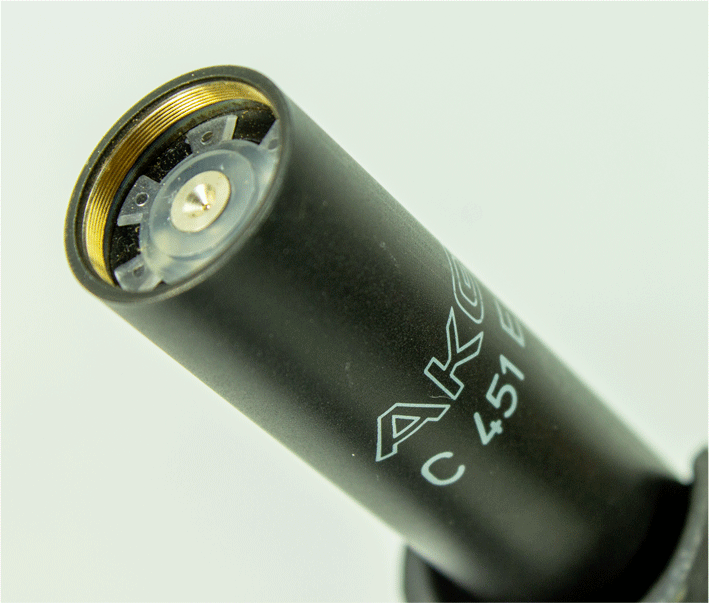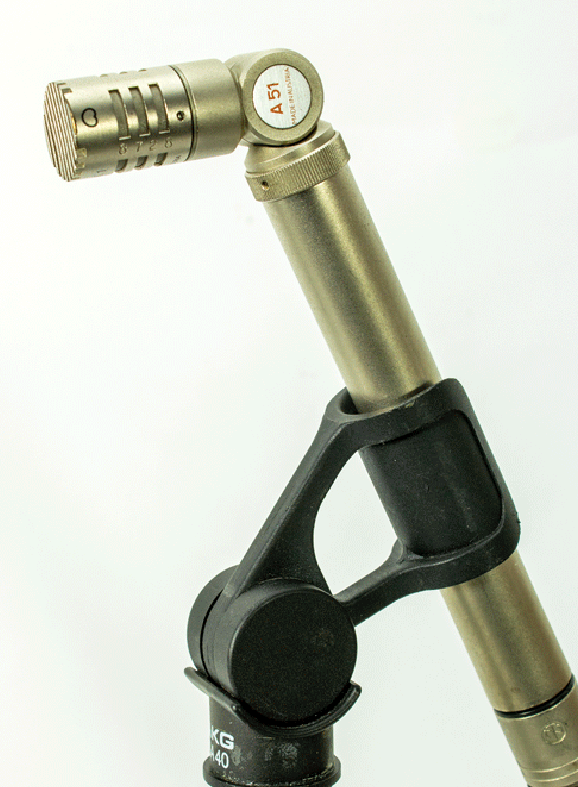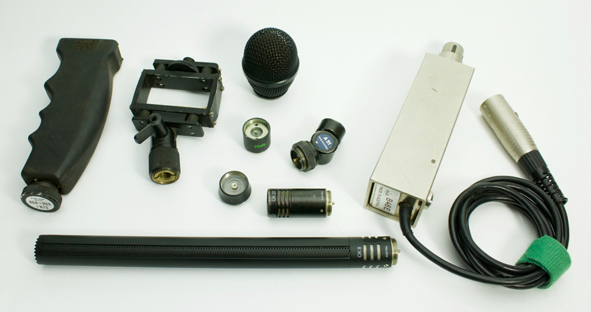|
Some vintage microphones are too good to forget about, the AKG CMS (Condenser Microphone Modular System) absolutely belongs in this category. It dates from 1969, and there are numerous recordings, that profited from the shine it attributed to the sound.
The system consisted of a super thin, 18 mm, C 451 preamplifier, with output transformer, made in two versions. Fitted with a DIN connector, as C 451 C, with a length of 114 mm, and as C 451 E, with a XLR3 and a length of 124 mm. Onto these, several different capsules could be attached: the CK 1 cardioid, the CK 2 omni and the CK 3 hyper cardioid, and the 610 mm long CK 9 rifle, for film and tv. Due to the great length of the tube with a diameter of 23 mm, the connection to the C 451 was designed in such a way that it protruded into the directional tube to achieve a better mechanical stability.
The C 451 was the first AKG FET condenser and it was phantom powered, so there was no longer a need for a special power supply. It could run on 12 to 48 Volts, on the new phantom power system, but it even functioned on 7,5 Volts, enabling power operation on a 9 Volt battery, with the B 46 portable power module.
At the time, professional studio recordings were made on tape, which benefitted from the accentuated high frequencies that the CMS system delivered.
For some these microphones produce too much highs for digital productions, but opinions differ. Keep in mind that there is not a single microphone that suits every sound source, and these vintage AKGs may seem too bright, if heard on their own, but they work remarkably well in the mix.
The BBC preferred them over the Neumann KM 84s. The capsules originally had embossed metal diaphragms that were susceptible to humidity and therefore these were replaced with plastic diaphragms with gold foil.
There remained just one problem with the system, AKG used a very fine thread for screwing the capsules on to the C 451, which was backward compatible with the earlier CK 26 omni and CK 28 cardioid capsules of the C 28 and C 60 tube condensers. Screwing on capsules could easily damage the thread and often changing capsules could wear the thread down.
For the BBC, AKG created special adapter pieces, which remained permanently screwed into the C 451 and had a larger internal thread with a smaller diameter. The capsules were equipped with matching threaded pieces.
A very handy part was the A 51 Knuckle, screwed between the c 451 and a capsule, like f.i. the CK 1, it allowed the capsule to be rotated 180 degrees, to aim it precisely at the sound-source. This is great for drums, like snare or toms, but also ideal for use of the system under the lid of a grand piano.
The number of capsules was extended, in 1972, with the CK 5, for vocals, with a 'floating' CK 1 capsule inside its metal basket. It had slightly reduced low frequencies, was less influenced by the proximity effect, and was also fit as a 'boom' microphone. The CK 8, with a length of 215 mm, was a short rifle capsule, but the standard feeble connection made it more prone to failure.
In 1977 the CK4 followed, (replacing the CK6) with a figure of eight pattern, with a CK 12 double membrane, like in the C 414, it was meant for Blumlein and MS recordings. The same year, the CK 22 was introduced, an omni directional capsule, like the CK 2, but better shielded against wind and a more even frequency pick up, better suited for classical recordings.
For the BBC there was also a C 451 version with two step low cut made, which would be the basis for the C 451 EB, from 1972, with a three way switch, for linear use , or with 75 Hz or 150 Hz low cut filter. The C 452 EB, from 1974, could only be power with 48V Phantom power.
In 1982, a successor of the c 451 was presented, the ultralinear C 460. This had a wider diameter of 22 mm, but needed to use the capsules made for the C 451, therefore AKG made an A 60 adapter to allow the use of the CK 1, and other small capsules, plus an all metal A 60M for the CK 4 and CK 8 heavier capsules. In 1984, a cardioid CK 61, an omni CK 62, and a hyper cardioid CK 63 were made.
In 2001, AKG presented the C 451 B, as a modernized copy of the original C 451/ CK1, claiming it had the same legendary sound. Spoiler: it does not, it is a non modular electret, without an output transformer, which shares the looks, but is of less quality.
Many prefer the original C 451s, especially for hi hat, cymbals and stringed instruments, but even vocals can sound superb with these legendary condensers. Since many were made, it is possible to find them for reasonable prices on the second-hand market.
These and many more types feature in my book Witnesses of Words. More information about that can be found at www.witnessesofwords.com

|
|
|
|
|
Above: AKG C451EB with CK1 capsule & A51 Knuckle
Below: sound, C451E with VR1 extension and CK1, Parts and the fragile thread of the C451 preamplifier |
|
|
|
 |
 |
|


 Video's
Video's Contact
Contact







